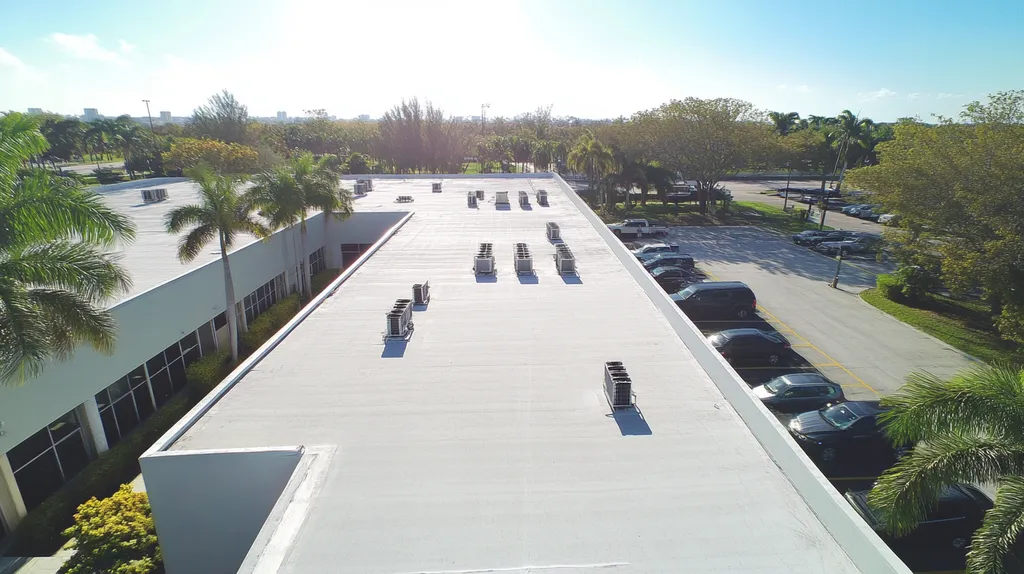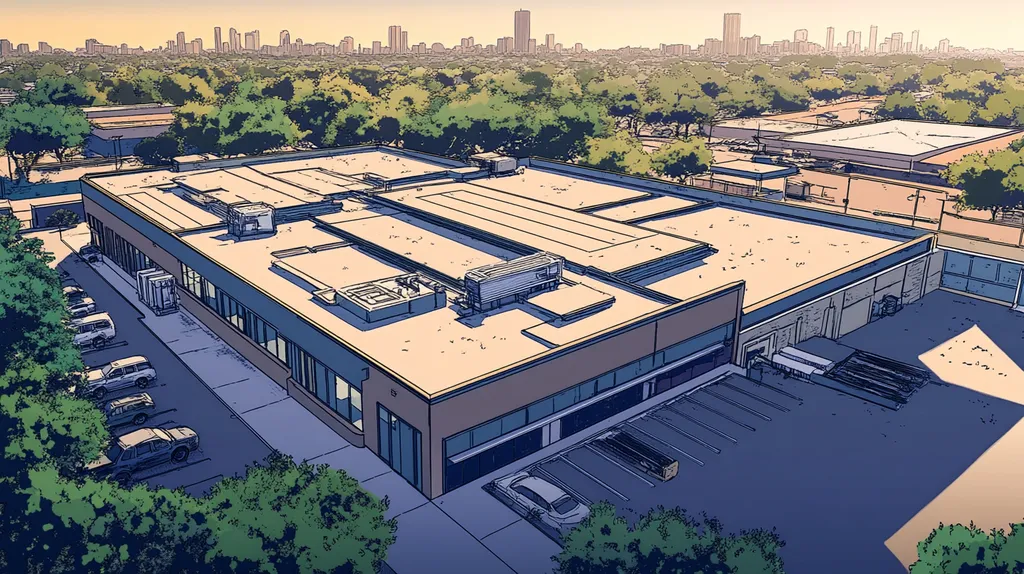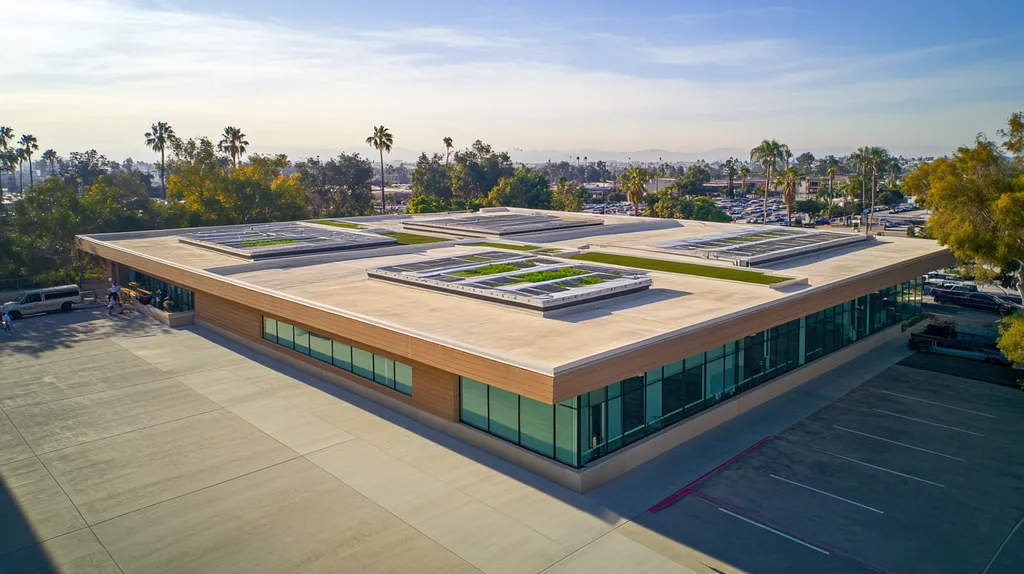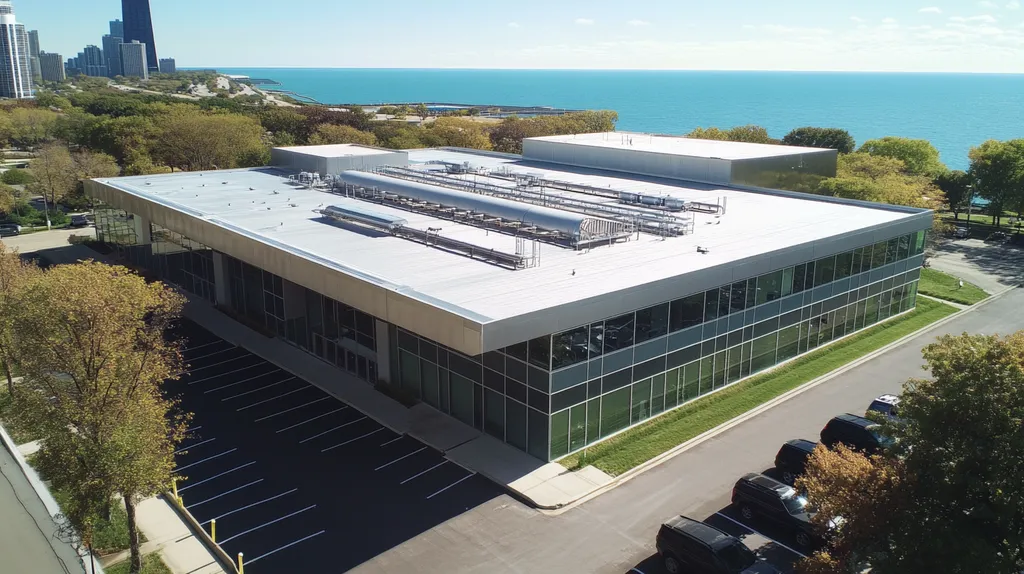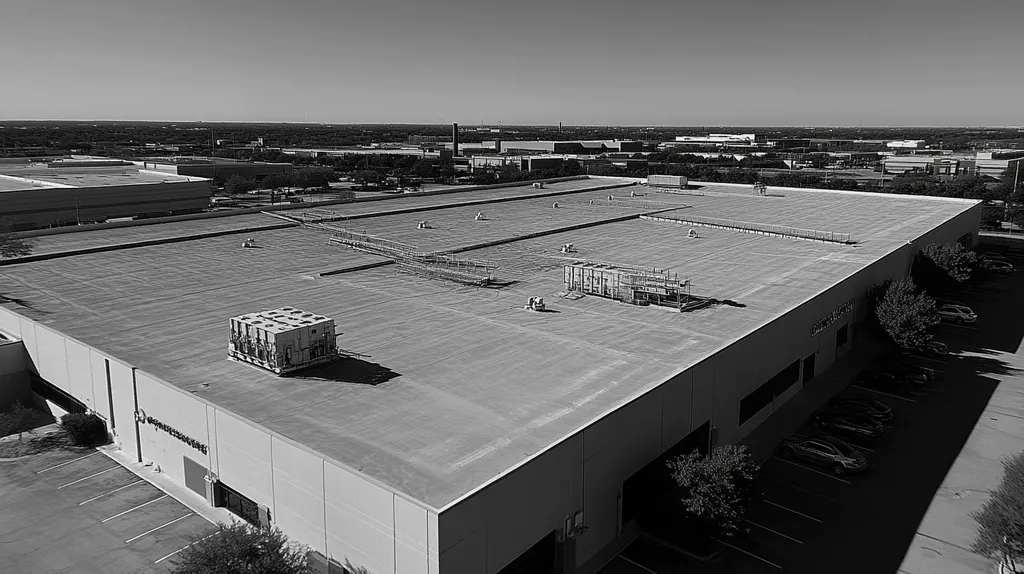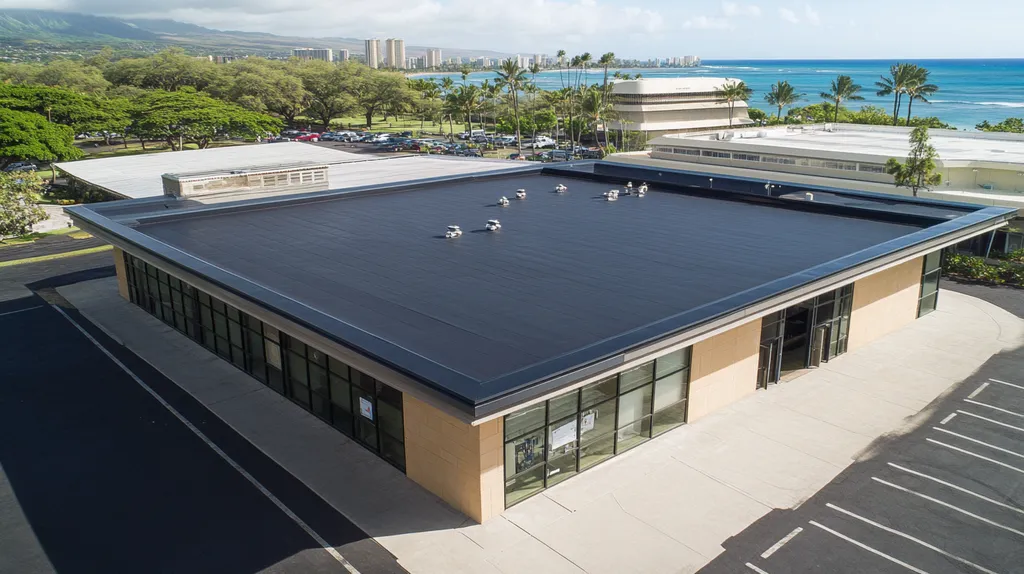In the high-stakes world of industrial roofing, the interaction between coatings and rooftop equipment can make or break a facility’s operations. Studies show that up to 40% of industrial roof failures stem from improper coating selection or application around equipment installations.
From HVAC systems to solar panels, today’s industrial roofs host an increasingly complex array of equipment that demands specialized coating considerations. The wrong coating choice can lead to equipment damage, energy inefficiency, and costly repairs.
This comprehensive guide examines the critical relationship between industrial roof coatings and rooftop equipment, breaking down the essential concepts, implementation methods, and maintenance strategies needed to protect these valuable assets.
SECTION 1: FUNDAMENTAL CONCEPTS
Property owners and facility managers need to grasp how roof coatings interact with rooftop equipment. This understanding is crucial because improper application can lead to costly damages and service interruptions. Did you know that the National Roofing Contractors Association (NRCA) links up to 75% of rooftop equipment failures to roofing issues? In this section, we’ll break down different types of roof coatings, explore the vital roles of permeability and vapor transmission, and highlight the importance of UV resistance to ensure both longevity and optimal performance.
Roof Coating Types and Characteristics
When it comes to roof coatings, variety is the name of the game! Different coatings are tailored for specific roofing materials and environments. Common types include acrylic, silicone, and polyurea coatings, each carrying unique characteristics that influence performance alongside rooftop equipment.
Acrylic coatings, for example, are incredibly flexible and perfect for buildings that see a lot of movement. However, when temperatures soar, silicone coatings shine with their thermal resilience. Knowing these properties helps in making smart choices that enhance roof longevity.
Moreover, some coatings can interact differently with rooftop equipment. While certain materials can elevate equipment performance, others may lead to unexpected wear and tear. Therefore, it’s imperative to choose a coating that aligns harmoniously with both the roofing system and the equipment in place.
Permeability and Vapor Transmission
Permeability is a game-changer when it comes to moisture management on roofs. Ideal roof coatings need to balance waterproofing with vapor transmission to prevent moisture accumulation beneath the surface. This balance is vital in avoiding issues such as mold growth and material deterioration that can impact both the roof and existing equipment.
If a coating is too impermeable, trapped moisture can spell disaster. In environments with fluctuating moisture levels, like warehouses, selecting a coating that supports proper vapor transmission is key. This ensures the roof remains intact without sacrificing efficiency.
On the flip side, coatings that allow for high permeability prevent pressure build-up, ensuring rooftop equipment functions optimally. By selecting coatings with suitable permeability ratings, property managers can effectively extend the lifespan of both the roof and the equipment.
Understanding vapor dynamics is essential not just for maintaining roof performance but also for protecting valuable investments.
UV Resistance and Durability
UV resistance is paramount in safeguarding both roof coatings and rooftop machinery. Continuous exposure to ultraviolet rays can degrade materials, resulting in premature failures that compromise both the roof’s integrity and equipment functionality.
Coatings with strong UV resistance can provide an extra layer of protection against degradation, significantly extending the service life of the roof. Property owners should seek out coatings that meet or exceed the industry’s UV protection standards to ensure durability.
Durability translates directly into functionality, reducing repair needs and minimizing equipment downtime. By opting for UV-resistant coatings, facility managers can create a formidable shield that protects both the structure and its rooftop assets.
In summary, the choice of coating should not only consider performance specifications but also environmental challenges to ensure rooftop equipment stays efficient throughout the roof’s life cycle.
SECTION 2: SYSTEM COMPONENTS
The integrity of industrial roofing systems hangs in the balance when coatings and equipment fail to mesh properly. Choosing the wrong materials can lead to significant issues like leaks, degradation, and costly repairs. Alarmingly, studies show that at least 30% of roofing problems arise from using incompatible materials. Understanding the essential components of your roofing system is crucial for ensuring both functionality and longevity. In this section, we will dive into compatible roofing materials, the formulations of coatings, and the bonding mechanisms that guarantee a strong adhesive connection.
Compatible Roofing Materials and Substrates
Selecting the right roofing materials is fundamental for achieving peak performance. Different substrates, such as asphalt, metal, or concrete, will interact differently with various coatings. For example, acrylic coatings are often a perfect match for built-up roofs, while silicone coatings work wonders on EPDM membranes.
Property owners need to consider the specific traits of their roofing substrate. If a coating is incompatible, it can deteriorate over time, resulting in leaks and additional problems. Moreover, warranty claims may be compromised if the wrong products are applied.
A thorough inspection of the existing roof condition is vital. This process ensures that any pre-existing damage won’t be aggravated by poorly matched materials. Regular inspections help catch potential issues early, preventing them from turning into bigger financial burdens.
Lastly, collaborating with knowledgeable roofing professionals can lead to better material choices. These experts can provide valuable insights into the most current technologies and products that enhance the longevity of roofing systems.
Coating Formulations and Ingredients
The formulation of roofing coatings is pivotal for their effectiveness and lifespan. Key ingredients such as resins, fillers, and solvents each play a role in the final product’s performance. For instance, urethane coatings are highly elastic and are particularly suited for areas experiencing thermal expansion.
By understanding these components, property owners can make informed decisions. High-quality ingredients typically offer superior resistance to UV rays and adverse weather conditions, which translates into a longer lifespan for the coating and the roof it protects.
Different coating types also possess unique properties tailored to various needs. Reflective coatings, for example, not only shield the roof but also help reduce energy expenses by keeping building temperatures lower. Recognizing the strengths of each type can lead to smarter investment choices.
Furthermore, the relationship between rooftop equipment and coatings is crucial. Many coatings are specifically designed to adhere to not just roofing materials but also the equipment that may be present, reducing the risk of future adhesion failures.
Adhesion and Bonding Mechanisms
Adhesion is a vital aspect of roofing coatings, influencing their performance on various substrates and equipment. Proper adhesion ensures that coatings stay intact, forming a reliable barrier. If the bonding agents are incompatible, it could lead to delamination that weakens the entire roofing system.
Several bonding mechanisms come into play, including mechanical interlocking and chemical bonding. Mechanical interlocking occurs when the coating physically grips the substrate, while chemical bonding relates to interactions between the coating and the molecules of the surface.
Surface preparation is critical for enhancing these bonding mechanisms. A clean, well-prepared surface ensures more effective chemical interactions and a stronger bond, while neglecting this step can result in early failure.
Additionally, environmental factors like temperature and humidity can impact adhesion. For example, high humidity may impede the curing process of certain coatings, resulting in weak bonds. Grasping these concepts is essential for achieving successful roofing project outcomes.
SECTION 3: IMPLEMENTATION METHODS
Implementing roofing coatings on industrial roofs isn’t just a routine task; it’s a vital step in ensuring the durability and performance of the entire system, especially when rooftop equipment is involved. A single misstep in the application process can compromise the roof’s integrity, leading to costly repairs and unexpected downtime. With studies revealing that many roof failures stem from poor preparation or application techniques, this section will guide you through the essential steps, including meticulous pre-coating inspections, effective application methods, and unique considerations for rooftop equipment.
Pre-Coating Inspection and Preparation
Before diving into coating application, a detailed pre-coating inspection is imperative. Facility managers should inspect the roof surface for signs of cracking, blistering, or any existing damage—issues that could worsen under a new coating. This careful examination ensures that the substrate is primed and ready for the coating materials.
Next, a clean roof surface is essential. Dirt, debris, and contaminants can interfere with how well the coating adheres. Studies show that roofs cleaned with pressure washers exhibit vastly improved coating performance compared to those left dirty. A clean slate is crucial for gripping power!
Rooftop equipment should also undergo inspection. Ensure that no HVAC units or other machinery are leaking or obstructing the coating application process. Any equipment evaluated for potential interactions with the coatings will help prevent costly malfunctions down the road.
Finally, don’t forget about repairs! Address any identified issues before advancing to the application phase. This proactive stance not only extends the roof’s lifespan but also boosts the effectiveness of the coating itself.
Application Techniques and Tools
The manner in which coatings are applied can massively influence their effectiveness. Various application techniques like spraying, rolling, and brushing each come with their unique set of benefits. For larger surfaces, spray application is often ideal, as it promotes even distribution and expedites coverage.
Equally important is the selection of high-quality tools. Brushes and rollers that are specifically designed for the coating type should be used to ensure consistent application. Using the wrong applicators could lead to uneven coverage, reducing the protective qualities of the coating.
Environmental factors are another key consideration. Each coating typically has a specified temperature range for optimal application. For instance, applying coatings in colder conditions may prevent them from curing properly, leading to early failures.
Adhering closely to the manufacturer’s application guidelines is critical. Following these recommendations not only aligns with best practices but also supports the expected performance of the coating.
Special Considerations for Rooftop Equipment
Rooftop equipment requires special attention during the coating process to prevent any complications. Equipment should be covered or temporarily removed to keep coating materials from interfering with their functions. Certain systems, such as exhaust fans and HVAC units, can be especially sensitive to improper coating applications.
Furthermore, compatibility of the chosen coating with the equipment is non-negotiable. Some coatings may react negatively with lubricants or other materials, leading to corrosion and malfunction. Consulting manufacturers for compatibility is important to avoid nasty surprises.
Adequate clearance around equipment is also essential to allow for proper ventilation during and after application, helping avoid any heat buildup that could negatively affect performance.
Last but not least, implementing routine inspections post-coating application can help catch any unforeseen issues between the coatings and equipment. Maintaining a checklist can ensure that everything is in top shape and ready to support a long-lasting, efficient roof.
SECTION 4: MAINTENANCE REQUIREMENTS
Keeping industrial roofing systems in top shape is more than just a good idea—it’s essential! Without regular maintenance, roofs can develop leaks and damage rooftop equipment, leading to expensive repairs and unexpected downtime. Implementing a thorough maintenance strategy not only protects the roof but also ensures the equipment underneath operates efficiently. This section will explore the must-do maintenance practices to support optimal roof performance.
Regular Inspection and Monitoring
Routine inspections are vital for spotting potential coating issues before they spiral into major headaches. It’s recommended to evaluate coatings at least every six months, focusing on areas surrounding rooftop equipment where wear is most likely. Keeping a close eye on signs like color fading or blistering is critical for maintaining roof health.
Utilizing trained personnel or reputable roofing contractors for these evaluations ensures that every crucial area receives attention. For instance, regularly checking seals around HVAC units and vents prevents moisture from sneaking in, protecting both the roof and the equipment underneath. Developing a detailed inspection checklist will help facility managers stay organized and thorough in their assessments.
Documenting inspection findings is also essential for tracking roof performance over time. Detailed records empower property owners to make savvy decisions regarding maintenance and repairs. Remember, the costs associated with preventive maintenance are often far less than those incurred from major roof repairs later on.
In conclusion, regular inspections and monitoring lay the groundwork for a proactive maintenance approach that significantly extends the life and performance of the roof.
Repairing Coating Damage and Leaks
Addressing coating damage promptly is essential to preventing a host of further complications. Even minor scratches or cracks can let water seep in, which could jeopardize both the roof and the rooftop equipment. Facility managers must tackle repairs head-on to maintain roofing system integrity.
Using the right materials for repairs is crucial. Opting for compatible coatings ensures a seamless bond with existing materials, reducing the risk of future failures. If leaks are discovered during inspections, swift action can stave off serious consequences, like mold growth and equipment corrosion.
Consider forming a rapid-response repair team to handle coating damage efficiently, minimizing disruptions to daily operations. Regular training on damage assessment and repair techniques will equip staff with the knowledge necessary to address issues effectively.
By prioritizing timely repairs of coating damage and leaks, property owners can safeguard their investments and reduce the chance of prolonged downtime.
Cleaning and Reapplication Schedules
Regular cleaning of roof surfaces is key to preserving coating performance. Buildup from debris, dirt, and algae can break down coatings over time, diminishing their protective abilities. Maintaining a consistent cleaning schedule ensures coats remain effective while enhancing the roof’s overall appearance.
Reapplication of coatings is another important maintenance task. Depending on the type, coatings may need reapplication every 5 to 10 years. Scheduling these reapplications in off-peak weather seasons can minimize disruptions to facility operations.
It’s wise to plan cleaning and reapplication schedules to avoid impacting rooftop equipment operations. For example, timing with HVAC maintenance can ease access to the roof and lower risks associated with servicing equipment.
In summary, establishing efficient cleaning and reapplication schedules is a vital aspect of maintenance that ensures coatings continue to perform optimally throughout the life of the roof.
SECTION 5: PERFORMANCE METRICS
Understanding the performance metrics of rooftop coatings isn’t just an option; it’s essential for property owners and facility managers. Coatings that don’t perform well can lead to disastrous water damage, rising energy costs, and premature roof replacements. In fact, a study revealed that a mere 20% increase in water repellency could extend a roof’s lifespan by multiple years! This section will delve into crucial performance metrics, emphasizing water repellency, energy efficiency, and longevity.
Water Repellency and Leak Prevention
Water repellency is a critical metric that determines how effectively coatings can protect against leaks. Quality coatings form a seamless barrier that prevents water from seeping in and causing damage to underlying materials. In fact, roofs with high water repellency can reduce leak occurrences by up to 75%!
It’s essential for property owners to regularly evaluate these coatings, especially after heavy rain or storms. Testing how well the coatings withstand ponding water can reveal their durability and readiness to protect. Coatings with superior water resistance and appropriate application techniques can significantly boost the longevity of the roof.
Moreover, a thorough maintenance routine should include careful assessments of the coating’s condition. Any signs of wear or degradation must be addressed immediately to prevent water intrusion. Investing in effective water repellency solutions not only minimizes repair costs but also helps safeguard your overall asset value.
In conclusion, outstanding water repellency enhances leak prevention while boosting the overall performance of the roofing system. Prompt attention to these issues can grant peace of mind to facility managers and property owners alike.
Energy Efficiency and Reflectivity
Energy efficiency directly affects operational costs in commercial and industrial environments. Reflective coatings are heroes when it comes to lowering roof temperatures, significantly reducing the cooling energy demands on HVAC systems. According to the Department of Energy, using reflective roofing can cut energy costs by as much as 30% during the hottest summer months.
Facility managers should prioritize the Solar Reflective Index (SRI) of their chosen coatings. The SRI rating measures how effectively a surface reflects solar energy, and elevated ratings correspond with greater energy savings. Choosing the right coatings can lead to lower energy consumption and a reduced carbon footprint!
Furthermore, energy-efficient coatings often qualify for various incentives or rebates, improving their financial feasibility. Many local governments encourage the installation of reflective coatings as a strategy to combat urban heat islands. Recognizing these benefits can direct decisions that promote sustainability goals.
In summary, investing in energy-efficient coatings brings immediate cost savings and enhances long-term value. Facility managers are encouraged to prioritize reflectivity in their roofing strategies to ensure peak building performance.
Longevity and Warranty Considerations
The longevity of roofing systems is largely influenced by the quality of the coatings applied. High-performance coatings can significantly extend roof life, sometimes exceeding 20 years with proper maintenance. Many manufacturers back their products with warranties, reflecting their confidence in the durability of their solutions.
Understanding warranty conditions is critical for property owners. Some warranties cover not just the materials used but also performance failures like loss of reflectivity or water resistance. Owners must comply with maintenance guidelines to validate warranties and protect their investments.
Regular inspections and maintenance can dramatically enhance the effectiveness of roof coatings. Coatings showing signs of degradation should be promptly addressed to avoid more severe damage. For instance, if a coating begins to peel or crack, immediate re-coating or repairs should be prioritized.
Ultimately, selecting coatings that come with solid warranties and committing to regular evaluations is vital for maintaining roof integrity. Longevity isn’t a coincidence; it’s the result of informed choices and proactive management.
SECTION 5: PERFORMANCE METRICS
Understanding the performance metrics of rooftop coatings is crucial for property owners and facility managers. Coatings that don’t perform can lead to costly water damage, increased energy bills, and the premature need for roof replacements. For instance, a study highlights that a mere 20% boost in water repellency could extend a roof’s lifespan for several additional years! This section focuses on key performance metrics, shedding light on water repellency, energy efficiency, and longevity.
Water Repellency and Leak Prevention
Water repellency is a pivotal metric that determines how effectively coatings protect against leaks. Top-quality coatings create a seamless barrier, preventing water from sneaking in and damaging the underlying materials. In fact, roofs boasting excellent water repellency can reduce leak incidents by as much as 75%!
Property owners should routinely check these coatings, particularly after heavy rains or long storms. Testing their ability to resist ponding water is essential, as standing water can accelerate deterioration. Opting for coatings with robust water resistance combined with proper application techniques can dramatically extend the life of the roof.
Additionally, a sound maintenance routine should incorporate evaluations of the coating’s condition. Catching any signs of wear or deterioration quickly can prevent water intrusion. By investing in outstanding water repellency solutions, property owners can cut repair costs and maintain their asset’s value.
In conclusion, superior water repellency enhances leak prevention while boosting the overall performance of the roofing system. Timely attention to these issues can provide peace of mind for facility managers and property owners alike.
Energy Efficiency and Reflectivity
Energy efficiency has become vital for managing operational costs in commercial and industrial settings. Reflective coatings play a heroic role by cooling down roof temperatures and significantly reducing the energy required by HVAC systems. The Department of Energy reports that reflective roofing can cut energy costs by up to 30% during the hottest months!
Facility managers should focus on the Solar Reflective Index (SRI) of their chosen coatings. This rating measures how well a surface reflects solar energy, and higher ratings mean greater energy savings. Selecting the right coatings not only fosters lower energy consumption but also helps reduce the carbon footprint.
Furthermore, energy-efficient coatings may open doors to specific incentives or rebates, enhancing their financial feasibility. Many local governments encourage the use of reflective coatings to tackle urban heat challenges. Recognizing these benefits can direct decisions that promote sustainability goals.
In summary, investing in energy-efficient coatings yields immediate cost savings while enhancing long-term value. Facility managers are encouraged to keep reflectivity at the forefront of their roofing strategies to ensure peak building performance.
Longevity and Warranty Considerations
The longevity of roofing systems is often influenced by the quality of coatings applied. High-performance coatings can significantly extend roof life, occasionally exceeding 20 years when coupled with proper maintenance. Numerous manufacturers back their products with warranties that demonstrate their confidence in durability.
It is essential for property owners to grasp warranty conditions. Some warranties cover not only the materials used but also performance failures like a loss of reflectivity or water resistance. Owners must adhere to maintenance guidelines to validate warranties and protect their investments.
Regular inspections and consistent maintenance can further prolong the effectiveness of roof coatings. If coatings show signs of degradation, they should be addressed promptly to prevent extensive damage. For example, peeling or cracking coatings require immediate re-coating or repairs.
Ultimately, choosing coatings supported by solid warranties and committing to regular evaluations is vital for maintaining roof integrity. Longevity is not a matter of luck; it is the result of informed choices and proactive management.
The Bottom Line
With over 40% of industrial roof failures linked to coating-equipment interactions, facility managers cannot afford to ignore this critical relationship.
The stakes are particularly high as rooftop equipment becomes increasingly complex and expensive, with a single coating failure potentially causing hundreds of thousands in equipment damage.
Success requires a strategic approach combining proper coating selection, meticulous application procedures, and rigorous maintenance protocols.
By following industry best practices for compatibility testing, surface preparation, and regular inspections, property owners can protect their investments and avoid costly failures.
The future of industrial roofing depends on this delicate balance between innovative coating technologies and the growing demands of rooftop equipment installations.
FREQUENTLY ASKED QUESTIONS
Q. How do coatings interact with rooftop equipment on commercial roofs?
A. Understanding the interaction between coatings and rooftop equipment is crucial. Improperly applied coatings can lead to equipment failures and increased repair costs. Choosing the right coating ensures compatibility, which prolongs both the roof’s and equipment’s lifespans, maximizing efficiency and minimizing disruption.
Q. What are compatible materials for coatings on an industrial roof?
A. Using compatible materials is key for effective performance. Different roofing substrates, such as metal or concrete, respond uniquely to various coatings. Selecting the correct materials prevents degradation, which can lead to leaks and expensive repairs, ensuring your roofing system remains intact and functional.
Q. What steps are essential for applying coatings on an industrial roof?
A. Pre-coating inspections are vital for identifying defects before applying coatings. A clean and well-prepared surface enhances adhesion, ensuring the coating performs effectively. Strategies like choosing the right application technique can further optimize results, protecting your investment and maintaining roof integrity.
Q. How often should I inspect coatings on my commercial roof?
A. Routine inspections should occur at least twice a year. This helps catch potential coating issues early, particularly around rooftop equipment where wear is pronounced. Regular monitoring prevents costly repairs by maintaining both the roof’s integrity and its associated equipment’s functionality.
Q. Why is water repellency important for coatings on industrial roofs?
A. Water repellency is critical as it prevents water infiltration, which can cause significant damage. Coatings with high water repellency can reduce leak occurrences dramatically, ensuring the roofing system lasts longer and minimizing maintenance costs. Protecting your roof from moisture ensures equipment remains undamaged.
Q. What maintenance practices should I adopt for my industrial roof?
A. Regular maintenance includes inspections, cleaning, and prompt repairs of any coating damage. Implementing these practices prevents issues from escalating, ensuring that the roof and rooftop equipment operate efficiently. Timely actions reduce long-term costs and extend the roof’s overall lifespan.
Q. How can I ensure coatings maintain optimal performance over time?
A. To keep coatings performing well, maintain regular inspection schedules and document any findings. Cleaning roofs regularly prevents buildup that can degrade coatings, while timely reapplications ensure protection from the elements. Combining these practices promotes long-lasting roof integrity and operational efficiency.

